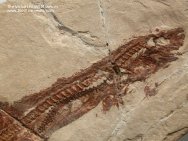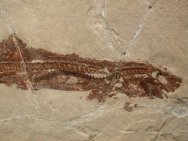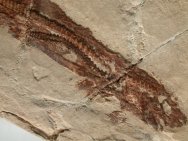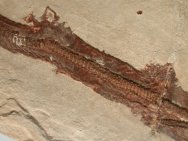Paratriakis
curtirostris
Class
Chondrichthyes, Order Galeiformes, Family Triakidae
Geological
Time: Middle Cretaceous, Middle Cenomanian Stage (~95 mya)
Size: 170
mm in length
Fossil
Site: Lebanese Lagerstatt, Hakel, Lebanon
|  Description:
Here is a fine shark from the Cretaceous sublithographic limestone
deposits of Lebanon. Since most of the skeleton of a shark is cartilage,
preservation of such details as seen here are uncommon. The fins
and basic body outline have also been preserved in wonderful detail.
Notice the rough nature of the skin, the result of preservation
of some of the denticles (‘little teeth”). Many cartilaginous
fish have denticles in the skin; indeed, true teeth may have evolved
from them in the dim past. The denticles of sharks are quite abrasive;
sharkskin (shagreen) has been used by some as a substitute for sandpaper.
The most unusual feature of this fossil is revealed in the close-up
of the interior of the specimen. There is a partial vertebral column
of a SECOND, smaller individual which served as the shark’s
last meal. Description:
Here is a fine shark from the Cretaceous sublithographic limestone
deposits of Lebanon. Since most of the skeleton of a shark is cartilage,
preservation of such details as seen here are uncommon. The fins
and basic body outline have also been preserved in wonderful detail.
Notice the rough nature of the skin, the result of preservation
of some of the denticles (‘little teeth”). Many cartilaginous
fish have denticles in the skin; indeed, true teeth may have evolved
from them in the dim past. The denticles of sharks are quite abrasive;
sharkskin (shagreen) has been used by some as a substitute for sandpaper.
The most unusual feature of this fossil is revealed in the close-up
of the interior of the specimen. There is a partial vertebral column
of a SECOND, smaller individual which served as the shark’s
last meal.
Fossil
sharks are rare. Fossil fish within fish fossils are very rare.
That would make a shark in shark fossil exhibiting cannibalism in
sharks possibly unprecidented. The genus Paratriakis is extinct,
but has a relative in the modern-day dogfish Triakis.
Also
see: Class Chondrichthyes
Fish Fossils
|
|





